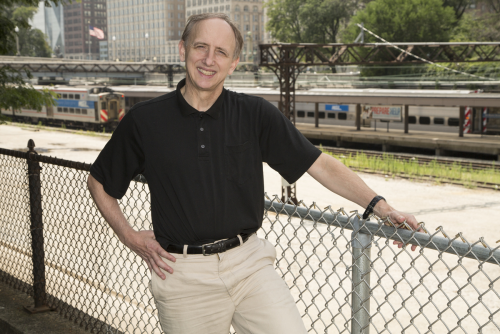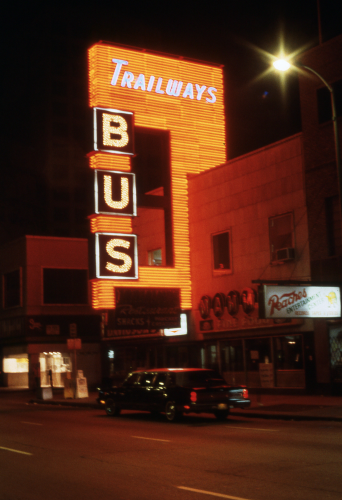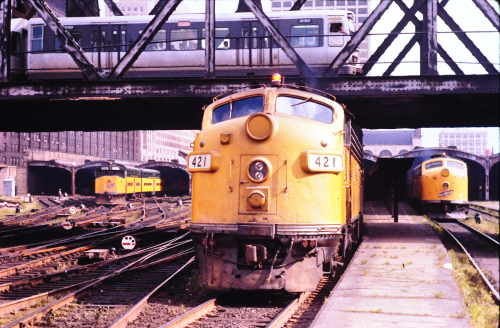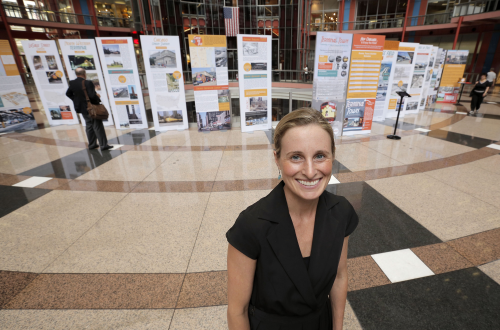Sep 02, 2014
‘Terminal Town’ places Chicago at epicenter of US air, bus and rail travel
‘Terminal Town’ places Chicago at epicenter of US air, bus and rail travel
DePaul University’s Chaddick Institute for Metropolitan Development is launching a six-month community program to explore Chicago’s history and future as the epicenter of U.S. passenger transportation. “Terminal Town: Celebrating 75 Years of Travel to the Windy City,” opens a traveling exhibit Sept. 1-5 at the James R. Thompson Center, 100 W. Randolph St., and continues through the fall with tours, events and a new 300-page illustrated guide by transportation expert Joseph Schwieterman.
“Chicago’s transportation system shoulders the enormous burden of moving people across the continent,” said Schwieterman, a professor in DePaul’s School of Public Service and director of the Chaddick Institute. “We recognize Union Station, Midway and O’Hare as great icons of American transportation, but there are many other terminals that deserve attention.”
For three decades, Schwieterman has been researching transportation and observing as terminals were bulldozed or built in Chicago. His new book, “Terminal Town: An Illustrated Guide to Chicago’s Airports, Bus Depots, Train Stations and Steamship Landings, 1939 to Present,” offers short narratives and vintage photos of 48 local intercity terminals. “The complex and ever-changing network has always been difficult for passengers to navigate,” Schwieterman said.
According to the author, some of the most dramatic changes have been to the city’s train terminals. Chicago once boasted the “Big Six” — Central Station, Dearborn Station, Grand Central Station, LaSalle Street Station, North Western Terminal and Union Station. Looking ahead, the book includes chapters on the extraordinary developments affecting Midway and O’Hare airports and the revival of intercity bus travel with the arrival of Megabus.
“While many of these beautiful terminals have been torn down, Chicago’s dominance in transportation is as strong as ever,” Schwieterman said.
The book is scheduled for release Sept. 15 by publisher Lake Forest College Press.
The Chaddick Institute offers a forum for analysis and debate about the region’s urban planning and transportation agenda, and Schwieterman hopes Terminal Town will inspire visionary thinking about the future of Chicago as a transportation hub.
“Our region needs better long-term solutions to integrate our sprawling bus and rail systems,” he said, and added that soon there will likely be enough demand for a third regional airport. “The dominance of Midway and O’Hare won’t last forever, and it’s only a matter of time before passenger travel through a third airport gains traction.”
Interactive exhibit on display at area libraries
The Terminal Town traveling exhibit draws largely from Schwieterman’s book and includes photos, video, and the history of lost and dormant terminals such as Englewood’s Union Station, the Chicago Greyhound Station and Meigs Field. One panel features movies, including “Home Alone,” “Blues Brothers” and “The Untouchables,” which have well-known scenes filmed in Chicago’s airports, train stations and bus terminals. Visitors will be able to use their smartphones to watch additional videos and take part in opinion polls and learn “fun facts.”
“Whether they're interested in history, architecture or film, visitors to the exhibit can enjoy a panorama of interactive features,” said Marisa Schulz, assistant director of the Chaddick Institute and the exhibit curator.
This fall, the exhibit will travel to several area libraries, including Orland Park, Illinois, from Sept. 6-30 at 14921 South Ravinia Avenue; Hammond, Indiana, from Oct. 1-26 at 564 State St.; and Wheaton, Illinois, from Nov. 16-Dec. 7 at 225 N. Cross St. In each community, visitors will have a chance to contribute photos and stories for contests, and nominate a townsperson or local leader who has helped celebrate the heritage of transportation and deserves to be commended.
Tours explore history, visit lost terminals
Researchers, staff and students from the Chaddick Institute will host a guided tour of the exhibit at the Thompson Center on Sept. 4 from 11 a.m.-1 p.m. The entire Terminal Town team will be on hand to share insights about the exhibition. The event is free. Register by emailing terminaltownchicago@gmail.com.
The Legacy of the “Big Six” Railroad Terminals walking tour will be held Sept. 26 from 2-5 p.m. Guest speakers will discuss future development plans for these historic sites and important terminals. The cost for the tour is $20. Register at http://www.terminaltown.org.
Other events this fall will include a “re-birthday” party to celebrate the renaissance of Midway Airport, as well as a tribute to railroad industry expert Norman Carlson. More information is available online at http://www.terminaltown.org.
###
SOURCE:
Joseph Schwieterman
Jschwiet@depaul.edu
312-362-5732

Transportation expert Joseph Schwieterman's latest book, “Terminal Town: An Illustrated Guide to Chicago's Airports, Bus Depots, Train Stations, and Steamship Landings, 1939 – Present,” explores Chicago's role as the epicenter of U.S. passenger travel. Schwieterman, a professor in the School of Public Service and director of DePaul's Chaddick Institute for Metropolitan Development, is also leading a six-month Terminal Town community program, including walking tours, an exhibit and events. (Photo by Jamie Moncrief)

The Chicago Trailways Station’s neon marquee illuminates Randolph St. in 1986. (Photo by Mel Bernero)

C&NW commuter trains cluster at the north end of North Western Terminal under the Lake St. “L” train in 1975. (Photo by Mark Llanuza)

Chicago Midway International Airport was a busy place in 1960, before airlines began migrating to O’Hare Airport in the following decade. (Photo by John Proctor)

Marisa Schulz, assistant director of the Chaddick Institute for Metropolitan Development at DePaul University, is curator of the traveling Terminal Town exhibit, seen here in the lobby of the James R. Thompson Center. (Photo by Jamie Moncrief)
